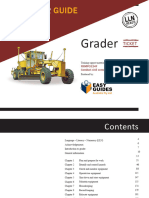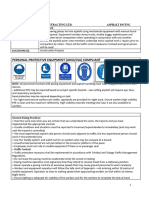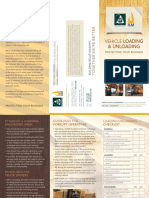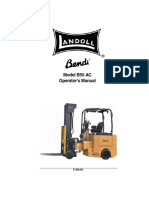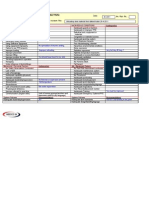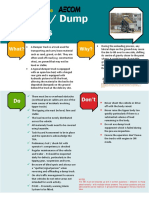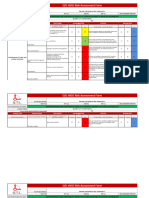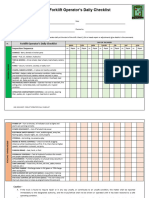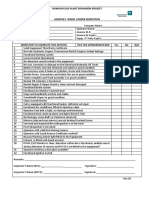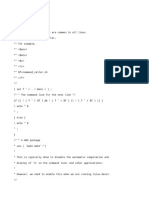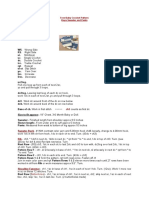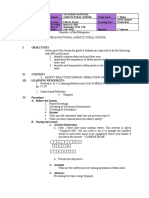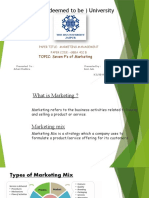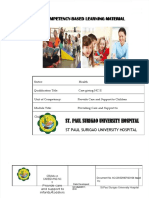Motor Grader Safe Work Procedure
Uploaded by
ScribdTranslationsMotor Grader Safe Work Procedure
Uploaded by
ScribdTranslations^[BASK AKOW SAFETY AND HEALTH MANAGEMENT SYSTEM AT
WORK
Department of Risk Prevention and
PR-GI-PTS-004 Version 1
Environment
SAFE WORK PROCEDURE:
MOTOR GRADE.
1
SAFETY AND HEALTH MANAGEMENT SYSTEM AT
BASK AKO W WORK
Department of Risk Prevention and
PR-GI-PTS-004 Version 1
Environment
1. DESCRIPTION AND OBJECTIVES
1.1. This document establishes the baselines for the correct and safe handling of motor graders in
production processes.
1.2. The objective of this SOP is to ensure that every person who works operating this equipment has a
clear knowledge of the procedures, obligations, controls and good practices for the safe handling of this type
of machinery.
2. REFERENCES
2.1. Current labor and safety law.
2.2. Internal regulations of order, hygiene and safety.
3. ROLES AND RESPONSIBILITIES
POST RESPONSIBILITY
General manager Approval manager
COO Responsible for creating and determining the
SOPs to be carried out.
Operations Manager Supervision
Shift manager Communication and diffusion of the
procedure
Risk Prevention Department Documentation administration.
Policy or Procedure
Starting processes
• The machine must only be used for the purpose for which it has been intended and always for
authorized and trained personnel for its use.
• The operator must become familiar with the operation of the machine before using it for
first time. You must know the function and direction of operation of each control, how to quickly stop
the engine, the possibilities and limitations of the machine, the space necessary to maneuver and the
mission of the safety devices.
• Pay special attention to all information and warning plates on the machine. Maintenance, repair or
any modification of the machine may only be carried out by specialized personnel.
• Every time the machine starts operating, its general condition must be checked. The machine controls
will only be used by authorized personnel and it is strictly prohibited for unauthorized personnel to
operate it even under the delegation of an authorized operator.
• Do not use the machine when any anomaly is detected during the daily inspection or during use. In
this case, put the machine out of service and notify immediately.
4, SAFE OPERATION PROCEDURES
Before starting to operate the equipment, the operator must clearly identify the position of the emergency
buttons. The personnel delegated for the operation of the equipment must have previously read the operating
instructions, in particular the safety instructions before operating the equipment. Continuous checks must be
carried out by the supervisor 2
^[BASK AKOW SAFETY AND HEALTH MANAGEMENT SYSTEM AT
WORK
Department of Risk Prevention and
PR-GI-PTS-004 Version 1
Environment
ensuring that the machinery operates as indicated in the operating instructions. View, read and understand all
visual instructions and warnings attached to the system or in the different work areas in which it operates.
In order to avoid risks, the motor grader operator must take into account the following points:
• You must respect the rules established at the work regarding circulation, signage and parking;
Respect speed and vehicle traffic lanes. You must know the status of the work: if there are open
ditches, embankments, cable routing, etc.
• You must know the height of the circulating machine, as well as areas of limited height or excessively
narrow tracks. While driving, the blade must be raised off the ground and must not protrude from the
body of the machine.
• When you have to get in or out of the cabin, you will do so facing it, using the steps provided for this
purpose, you will not go up or down by jumping. Nor will it do so if the grader is moving.
• The motor grader is not prepared to carry people.
• Use extreme caution when working near ditches or embankments.
• To avoid impacts when loading trucks, the operation will be carried out with caution and without the
driver being inside or in the tub area.
• When the machine is stopped, the operator will leave the blade raised without protruding
of the width of the machine body
• To prevent overturning when material is being removed, the grader will be
arranged facing the slope.
• Do not leave the vehicle on steep ramps or near ditches.
• Avoid driving in areas that exceed a slope of approximately 20%.
• When driving on slopes the machine must be in gear; it will never be in neutral. The motor grader
must have acoustic reverse gear signaling and light signaling.
• You will have the instructions and maintenance manual.
• After driving through places with water, the grader operator
will check the proper functioning of the brakes.
• He will ensure the proper functioning of the light signaling device when the machine is running, and
also the acoustic device for reversing.
• Maintenance and interventions on the engine must be carried out by appropriately trained personnel,
preventing projections of high-temperature liquids, fires due to flammable liquids or being trapped by
handling running engines or moving parts.
5. BEFORE YOU START WORK
RISKS - PREVENTIVE MEASURES
Entrapment of the operator due to the machine overturning, hitting objects, hitting other workers, running over
and electrical contact:
• Know the safety instructions contained in the site's Health and Safety Plan for carrying out work with
this type of machine.
SAFETY AND HEALTH MANAGEMENT SYSTEM AT
BASK AKO W WORK
Department of Risk Prevention and
PR-GI-PTS-004 Version 1
Environment
3
• Be informed every day of other jobs that may generate risks (holes, ditches, etc.), of the simultaneous
performance of other jobs and of the state of the work environment (slopes, obstacles, ice, etc.).
• Know the workplace where the machine will move or work. Especially, the type of terrain, the points
where there may be height, width or weight restrictions and the presence of overhead power lines.
Crashes against other vehicles, hits to other workers and run overs:
• Follow the traffic rules established on the construction site and, in general, those marked in the
Highway Code.
• If necessary, place appropriate protections regarding the circulation area of pedestrians, workers or
vehicles (fences, signs, etc.).
• The machine must be registered to be able to circulate on public roads and must have the required
safety and signaling elements (rotating light, rear-view mirrors, etc.).
• To circulate within the construction site, it is recommended that the driver have at least a class D
driving license. When traveling on public roads, the driver must possess it.
Carbon monoxide inhalation poisoning and asphyxiation:
• You can only work with the machine in closed places (inside warehouses, tunnels, etc.) when it can
be guaranteed that adequate and sufficient ventilation will be maintained during the work. In this
case, the engine must be stopped when the machine is not in use.
Fire and Explosion:
• Never use the machine in potentially explosive atmospheres (near storage of flammable materials
such as paint, fuel, etc.).
Entrapment of the operator due to the machine overturning and objects falling onto the driving position:
• Avoid driving and working near the edges of excavations, ditches, slopes or unevenness. If
necessary, the machine must have a rollover protection structure (ROPS).
• The edges of excavations and castings must be marked off and have elements that warn the operator
that he is approaching them excessively.
Impact of objects:
• Avoid carrying out work in areas where there is a risk of objects falling onto the driving position. When
necessary, the machine must have a protective structure (FOPS) in the direction of the object's fall
(top, front, side or rear).
• Check the existence of a plate on the machine that ensures the arrangement of these structures.
Blows due to lack of visibility and dust inhalation:
^[BASK AKOW SAFETY AND HEALTH MANAGEMENT SYSTEM AT
WORK
Department of Risk Prevention and
PR-GI-PTS-004 Version 1
Environment
• When there is excess environmental dust in the workplace, as a result of the circulation of other
vehicles or the work itself, and the machine does not have a closed cabin, it is recommended to
moisten the area beforehand, so that dust is avoided. but without producing sludge.
Direct electrical contact, fire, explosion and poisoning due to inhalation of toxic gases:
• Know precisely the location and depth of underground conduits (water, gas pipes, sewage networks
and electrical cables). When it is not possible to know the exact location of the underground electricity
and/or gas conduits, metal detection devices must be used to locate them.
4
Blows due to lack of visibility and loss of control of the machine:
• When natural lighting is insufficient, work must be stopped if the machine does not have its own
lighting system or if there is no artificial lighting that guarantees adequate visibility in the workplace.
• Suspend work when weather conditions are adverse (fog, rain, etc.).
• Large loads should not be handled under strong winds.
Fall of the blade on the lower limbs and blows:
• When it is necessary to change the blade for another of a different size, the machine must be placed
on firm, level ground and the blade must rest completely on the ground.
• Use a soft hammer or ejector punch to insert or extract the pins. Use gloves and safety glasses
during these operations.
• Never exceed the maximum sheet size recommended by the manufacturer
6. INDIVIDUAL PROTECTION EQUIPMENT
The operator of the motor grader must use leather gloves, a lumbar belt to avoid vibrations; If necessary, you
will also use hearing and vision protectors and dust masks. During work outside the cabin, in the construction
space, you will use a safety helmet, safety shoes and a reflective vest if necessary.
The grader must have a roll-over cabin to protect the risk of being trapped in the event of a rollover. To do
this, and to avoid damage from impacts, you must use the seat belt. The ideal cabin is one that protects
against inhalation of dust also produced by the worker with the same motor grader and that enters the eyes,
against deafness caused by the noise of the motor grader and against thermal stress or sunstroke in summer.
Other recommendations:
• Wear work clothes with adjustable cuffs. It is not recommended to wear pendants,
chains, loose clothing, etc. that can get caught with elements of the machine.
• The personal protective equipment that appears in the Safety Plan must be used.
Safety and Health for the situations indicated therein. Below is an example of the equipment that is
typically used:
SAFETY AND HEALTH MANAGEMENT SYSTEM AT
BASK AKO W WORK
Department of Risk Prevention and
PR-GI-PTS-004 Version 1
Environment
- Security shoes. Its use is mandatory in a work. It must have a sole
anti-puncture/non-slip.
- Protective helmet. It should be used when the machine does not have a roof
protector or when when getting out of the cabin there is a risk of falling objects or hitting the head.
- Safety glasses. They should be used when the driving position does not have a windshield and
there is a risk of objects being projected into the eyes.
- Auditive protectors. It will be mandatory when the noise exposure value exceeds 87 dB(A).
- Gloves. Its use is recommended in operations to control the state of the
machine.
- Reflective clothing or vest. It will be mandatory when there are other vehicles
working nearby.
7. DAILY CHECKS
• Verify that the machine has no obvious structural damage or liquid leaks.
• Check that all safety and protection devices are in good condition and are correctly positioned (engine
5
cover, fuel tank cap, etc.).
• Check that the fuel, hydraulic oil, engine oil, engine fluid levels are
brakes and coolant are adequate. Fill if necessary.
• Verify that the light and acoustic devices are in perfect condition and
they work right.
• Keep the driving position, footrests and handles clean and free of oil, grease, mud, ice, etc.
• Keep the driving position free of objects or tools that can
move freely preventing the performance of a specific maneuver.
• Check the good condition and adjustment of the mirrors and keep the mirrors clean.
cabin windshield.
• Verify that the seat belt and its anchorage are in good condition and that the
seat adjustment is appropriate to the weight and measurements of the operator.
• Check that information and warning signs remain clean and in place.
good condition.
8. WHEN STARTING THE MACHINE
RISKS - PREVENTIVE MEASURES
Falls from different levels, uncontrolled movements and blows when leaving:
• Get on and off the machine from the front using the corresponding steps and handles.
• Do not use the steering wheel and/or levers as handles to get on or off the machine.
• Do not jump off the machine except in case of emergency.
• Hands must be worn and kept dry and soles clean of mud and/or grease.
• Once seated, fasten your seat belt.
^[BASK AKOW SAFETY AND HEALTH MANAGEMENT SYSTEM AT
WORK
Department of Risk Prevention and
PR-GI-PTS-004 Version 1
Environment
Hits by elements of the machine, hits to other workers, run overs and collisions with other vehicles:
• The machine should only be started and operated from the operator's position.
• Before starting the engine, check that there are no workers within the range of the machine. Ensure at
all times that no one can remain within the radius of action of the machine during its use or
movement.
• When the simultaneous performance of other jobs, unrelated to operations with the machine itself,
cannot be avoided, coordination between jobs must be established.
Uncontrolled machine movements, risks resulting from poor maintenance and damage to the machine:
• Before starting the engine, verify that all levers and controls are in the neutral position.
• Follow the manufacturer's instructions to start the machine engine.
• Once in operation, verify its proper functioning by observing the
light witnesses. The oil pressure and battery charge indicators should go out when the engine is
running.
• Next, using slow maneuvers, check that all the controls respond perfectly, especially those
corresponding to the braking systems (service and parking).
• Start working when the hydraulic oil reaches normal working temperature.
9. WHEN RIDING WITH THE MACHINE
RISKS - PREVENTIVE MEASURES
6
Falls at different level:
• Other people may only be transported on the machine when the machine manufacturer has provided
a second seat.
• Do not extend any part of your body out of the driving position.
Loss of control of the machine, entrapment of the operator due to the machine overturning, hitting objects and
collisions with other vehicles:
• Preferably drive on well-established, dry, clean tracks or terrain free of obstacles.
• Maintain a safe distance from the edges of excavations, ditches, uneven ground, etc.
• Adapt the speed to the working conditions and the state of the terrain, always respecting the
maximum speed established on the job.
• Avoid making sudden maneuvers such as braking, accelerating or turning at speed.
elevated.
• Drive at a moderate speed when the machine is loaded, maneuvering
always gently.
• Always maintain a safe distance when driving near other machines.
• Use extreme caution at intersections with poor visibility.
SAFETY AND HEALTH MANAGEMENT SYSTEM AT
BASK AKO W WORK
Department of Risk Prevention and
PR-GI-PTS-004 Version 1
Environment
• Coordinate with field personnel the correct execution of cleaning stakes, ensuring the correct
movement of personnel and machinery.
Hitting objects, Trapping the operator due to the machine overturning, Hitting other workers and running over:
• Always follow the path of the machine with your eyes.
• Before to start any movement, verify that both the blade and the
superstructure are oriented correctly in the direction of travel.
• Before to reverse the meaning of the march, check that there is space
sufficient and that there are no ditches, holes, objects, etc.
• If the machine has acoustic reverse signal, keep it activated
while working with the machine inside the construction site. To travel on public roads you must
disconnect.
• If not available, the horn must be activated before starting a reversing maneuver.
Strikes against objects:
• During movement, the blade tilting device must be kept locked.
• Do not manipulate the blade levers when the machine is moving.
Operator entrapment due to machine overturning:
• Avoid going up or down curbs. If necessary, ramps with a reduced slope must be installed that are
made of a material capable of supporting the weight of the machine.
• Never approach unconsolidated slopes.
• Keep a safety distance to its side edges.
• Never drive in a transverse direction to the slope.
• Never drive on terrain with slopes greater than those recommended by the manufacturer.
ATTENTION! The recommended slope does not mean that it can be maneuvered with complete
safety in any load, terrain or maneuver condition.
• In any case, it is not advisable to exceed slopes greater than 55%.
• When driving on slopes, always do so up or down, avoiding
performing turns.
7
• When going up or down sloping terrain, keep the blade extended and
oriented towards the ground, with the teeth located approximately 20-30 cm from the ground.
• In this way, if the machine loses stability, the blade can be immediately lowered to the ground to act
as a brake.
10. WORKING WITH THE MACHINE
RISKS - PREVENTIVE MEASURES
Direct electrical contact and Fire:
• As a general rule, in the presence of buried pipes, this machine can only be used until reaching a
distance of 1 m from the pipe. Between 1 m and 50 cm
^[BASK AKOW SAFETY AND HEALTH MANAGEMENT SYSTEM AT
WORK
Department of Risk Prevention and
PR-GI-PTS-004 Version 1
Environment
mechanical tools must be used. Below 50 cm, approach work must be carried out manually.
Blows against fixed objects, falling objects on workers, entrapment, uncontrolled movement, loss of stability
and projection of materials:
• Before starting a maneuver, check that the blade cannot come into contact with any obstacle when
raising or tilting it. Do not force the machine beyond its capacity.
• The raising and lowering movements of the blade should be done smoothly.
Operator entrapment due to machine overturning:
• Avoid carrying out work on sloping terrain. If necessary, always work facing the slope with the blade
positioned as close to the ground as possible. Never turn the superstructure when on sloping ground.
Operator entrapment due to machine overturning:
• When it is necessary to approach the edge of excavations, ditches or similar to unload the material,
end of travel stops must be placed. These stops must be of sufficient material and strength to prevent
the advance of the machine.
11. AT THE END OF THE JOB
RISKS - PREVENTIVE MEASURES
Blows against machine elements:
• Never leave the driving position without first stopping the engine.
• Rest the blade on the ground even if it is for short stops.
Collisions with other vehicles, land collapse and uncontrolled movement of the machine:
• When finishing the work, park the machine on a surface that is as level and resistant as possible,
where it does not impede the passage of other vehicles or people.
• As a general rule, do not park the machine closer than 3 m. from the edge of
excavations or similar.
• If parking on a slope, point the grader towards the side.
up the slope and rest the blade on the ground, keeping the boom extended.
Blows against machine elements and uncontrolled movement of the machine:
• Use of the machine by unauthorized persons.
8
• Once parked, place both the blade and the blade on the ground.
• Put all controls and levers in neutral position.
• Lock the superstructure rotation device.
• Follow the manufacturer's instructions to stop the machine motor.
• Then raise the control arm.
• Remove the ignition key to prevent use by unauthorized personnel.
SAFETY AND HEALTH MANAGEMENT SYSTEM AT
BASK AKO W WORK
Department of Risk Prevention and
PR-GI-PTS-004 Version 1
Environment
12. CONTROL OF THE MACHINE STATUS
RISKS - PREVENTIVE MEASURES
Fire and explosion:
• Refuel in well-ventilated areas with the engine stopped, the blade resting on the ground, the parking
brake applied and the battery disconnected.
• Do not smoke or remain on the vehicle while refueling.
• Avoid proximity to operations that may generate a source of heat.
• Do not store greasy rags or flammable materials near the exhaust pipe.
• If you do not refuel with a hose, pour the fuel into the tank with the help of a funnel to avoid
unnecessary spills.
• If fuel is spilled, do not start the engine until the spilled liquid has been cleaned up.
• If fuel containers are available on site, store them in a place specifically designated for this and mark
them with a label indicating “DANGER, FLAMMABLE PRODUCT” visibly.
• A fire extinguisher must be available in an accessible place near the machine or on it if the
manufacturer has equipped it with a fixing system for the fire extinguisher.
Burns and splashes and contact with hot and/or corrosive liquids:
• Do not touch the exhaust pipe or other engine parts while the engine is running or remains hot.
• Always fill the coolant, engine oil or hydraulic oil tanks with the engine stopped and cold. Use anti-
projection glasses and gloves during this operation.
13. SAFE MOTOR GRADE OPERATION
13.1. The operator must respond only to maneuver signals made by the designated person, but will obey the
stop signal made by any person at any time. The person in charge of signals, fully qualified by training or
experience, must be prepared when the operator does not have a direct and complete view of the point of
operation, unless there is an effective signaling or control system, for the direction operator. The person in
charge of signaling must be in a sufficiently illuminated area to be clearly visible to the operator during night
work. A legible table describing and explaining the signal system used must be posted in a visible location.
Make sure you and the signaller agree and understand them beforehand. Do not start work until the signs are
clearly understood. Remember that it is as important to see as it is to be seen. It is preferable to use exterior
lighting when in the slightest doubt. Other non-manual signal systems must be protected against
unauthorized use, breakage, weather or obstructions that will be detrimental to safe work.
13.2. START SAFELY.
Climb up carefully, using the handholds for this purpose. Do not jump. When getting on or off, check to see if
the ground or surface is slippery. Check all controls to ensure they are in the correct position before starting.
Consult the manufacturer's manual.
9
^[BASK AKOW SAFETY AND HEALTH MANAGEMENT SYSTEM AT
WORK
Department of Risk Prevention and
PR-GI-PTS-004 Version 1
Environment
Check for warning labels. If there is a warning label on the starter switch or engine starting controls, do not
close the switch or start the engine until the person who placed it or someone who is aware of the
circumstances removes it. Never attempt to start the engine from a location other than that indicated for the
operator. Exhaust gases can kill, if it is necessary to start the engine in a closed area, provide adequate
ventilation. Never leave the operator's cab with the engine running. Sound the horn before starting the
engine.
13.3. IMMEDIATELY AFTER STARTING THE ENGINE.
Check all gauges for proper readings. Secure the work area visually. Operate all controls, check that they
work properly. Listen for unusual noises. Check engine speed control. Check the indicator lights and all
warning and safety systems. Run the engine for a few minutes at idle to reach its working temperature range.
Record all security defects for immediate correction.
13.4. IN COLD WEATHER.
Consult the manufacturer's operation manual for a correct starting procedure. Slowly operate the controls
until the hydraulic oil is warmed to a correct operating temperature. Extend your engine's idling period before
starting work. Do not store containers of cold weather starting aids or other flammable materials on the
grader. Make sure that these types of materials are away from sources of heat, sparks or flames. Do not
puncture or burn the containers. They could explode.
13.5. BE ALERT WHILE WORKING.
Not read. Do not drink. Do not eat. Pay attention to the work. If you need to pay attention to any other part,
stop the machine. Never allow ground personnel to stand behind you, keep them in areas well visible to the
operator.
13.6. KNOW THE WORKING SCOPE OF THE MOTOR GRADE.
Make sure the accessory or load will not trip over any obstacles when lifting or turning it. Do not turn, lift or
brake with unnecessary speed, accidents may occur. Make sure the area is clear before moving or turning in
any direction. NEVER turn or stop attachment or load over ground crew or truck cab. NEVER allow anyone
on loading equipment, it is extremely dangerous. Never attempt to start or operate the grader from any
location other than the operator's location. Handling it from any other position, such as reaching out from a
door or window, constitutes a serious danger. Do not load a truck until the truck operator is in a safe location
or is not allowed to leave the cab. Do not drop the material from excessive heights.
14. FAULT PROCEDURE
In case of failure of the equipment or a part of it, you must first check the emergency button or the engine
stop indicators, fuel, electrical or oil levels, among others. If any of these events exist, call maintenance.
1
0
SAFETY AND HEALTH MANAGEMENT SYSTEM AT
BASK AKO W WORK
Department of Risk Prevention and
PR-GI-PTS-004 Version 1
Environment
If the lights or reverse signal do not work. Abnormal noises are heard during operation. There is a smell of oil
or fuel in the machine. It presents looseness or breaks in footings or structures. It has oil or liquid leaks. Does
not turn on the machine.
In general, if the problem cannot be resolved by manual operation of the controls, make sure the equipment
is turned off and in safe condition before attempting future repairs. If you have any questions, contact
maintenance or the shift supervisor.
15. PROCESS MAP
16. TRAINING PLAN
Every person who enters to work in Baskakow, as a motor grader operator, must read and understand this
procedure, which will be explained by the shift supervisor or person who replaces him or her. For this, you will
be given a copy of this SOP. The objective of this is that when reading the safe work procedure for painting
on mechanized lines you clearly know what the fundamentals or basic safety criteria are in order to properly
apply them in your work.
In addition to the above, the operator will be required to have all his documents and driving licenses up to
date.
1
1
^[BASK AKOW SAFETY AND HEALTH MANAGEMENT SYSTEM AT
WORK
Department of Risk Prevention and
PR-GI-PTS-004 Version 1
Environment
17. EMERGENCY SITUATION
In case of emergency from the workplace, immediate assistance must be requested by telephone to the
following numbers (ACHS):
• Chilean Security Association, (Santiago)
• Address Ramón Carnicer 185, Providencia, Metro Bustamante
• Telephone 800800 1404.
• Expert
• Carabineros 133
• Firefighters 132
• SAMU 131 ambulance
• Ambulance ACHS 1404
Suspend work immediately and allow the area to be evacuated. Immediately inform the corresponding labor
inspection and regional ministerial secretary of health. Fatal Work Accident: an accident that causes the
death of the worker immediately or during transfer to a healthcare center. Serious Work Accident: any work
accident that:
• Force resuscitation maneuvers, or
• Force rescue maneuvers, or
• Occurs due to a fall from a height of more than 2 meters, or
• Causes, immediately, the amputation or loss of any part of the body,
either
• Involve such a number of workers that it affects the normal development of the affected task.
Affected Site: that area or workplace in which the accident occurred, and may even cover the site as a whole,
depending on the characteristics and origin of the accident, and accident for which, if the company does not
adopt immediate corrective measures, endangers the life or health of other workers.
In the event of suffering an accident, you must also notify:
• Project Manager:
either Rodrigo Díaz Soto.
either +569 4274 3738
• Operations Manager:
either Fabián Astroza Villarreal.
either +569 6596 8962
1
2
You might also like
- Risk Assessment For Loading, Offloading& Unloading PSS Tokadeh 002.Pdf1100% (1)Risk Assessment For Loading, Offloading& Unloading PSS Tokadeh 002.Pdf12 pages
- Fork Lift Truck-Risk Assessment - Date: R A - S A /SNo ratings yetFork Lift Truck-Risk Assessment - Date: R A - S A /S2 pages
- Fork Lift Daily Check: (Only For FL Operated by Batery)No ratings yetFork Lift Daily Check: (Only For FL Operated by Batery)1 page
- Daily Inspection Checklist: Walking Pallet Truck::: Operator's Name Signature Equipment ID #: Shift: DeptNo ratings yetDaily Inspection Checklist: Walking Pallet Truck::: Operator's Name Signature Equipment ID #: Shift: Dept1 page
- Daily Pre Use Inspection For Powered Industrial Trucks100% (1)Daily Pre Use Inspection For Powered Industrial Trucks2 pages
- Jersey Barrier Installation 2016 VersionNo ratings yetJersey Barrier Installation 2016 Version2 pages
- Skid Steer Loader Safety: For The Landscaping and Horticultural Services IndustryNo ratings yetSkid Steer Loader Safety: For The Landscaping and Horticultural Services Industry44 pages
- Forklift Safety - Deadly When Operated IncorrectlyNo ratings yetForklift Safety - Deadly When Operated Incorrectly37 pages
- Field Safety - Bucket Truck Practical EvaluationNo ratings yetField Safety - Bucket Truck Practical Evaluation2 pages
- Bendi B55 AC Operators HALF SIZE Manual F-595-R1No ratings yetBendi B55 AC Operators HALF SIZE Manual F-595-R182 pages
- SW08344 Guide For Unpacking Shipping ContainersNo ratings yetSW08344 Guide For Unpacking Shipping Containers14 pages
- OPEX Awareness Dangers in Loading and Unloading Heavy Equipment PDF100% (1)OPEX Awareness Dangers in Loading and Unloading Heavy Equipment PDF2 pages
- Requirements For Checklists Before Putting A Forklift Into UseNo ratings yetRequirements For Checklists Before Putting A Forklift Into Use11 pages
- # Inspection Item Yes N o N/A: Appendix B Crane & Hoist Monthly Inspection Checklist Page 1 of 2No ratings yet# Inspection Item Yes N o N/A: Appendix B Crane & Hoist Monthly Inspection Checklist Page 1 of 22 pages
- SOP TR016 - Operating A Skidsteer - VolvoNo ratings yetSOP TR016 - Operating A Skidsteer - Volvo2 pages
- Safety Training for Powered Pallet Truck OperatorNo ratings yetSafety Training for Powered Pallet Truck Operator26 pages
- STFC Lifting Plan, Risk Assessment and Method Statement: Details of Loads Load Position 1 Load Position 2 Load Position 3No ratings yetSTFC Lifting Plan, Risk Assessment and Method Statement: Details of Loads Load Position 1 Load Position 2 Load Position 34 pages
- Operation & Safety, Service & Maintenance & Illustrated Parts Manual SupplementNo ratings yetOperation & Safety, Service & Maintenance & Illustrated Parts Manual Supplement28 pages
- General Maintenance Risk Assessment 2011No ratings yetGeneral Maintenance Risk Assessment 20119 pages
- GRC Overhead Crane Daily Checklist - NasaNo ratings yetGRC Overhead Crane Daily Checklist - Nasa2 pages
- HSE Professionals - Colour Coding SystemNo ratings yetHSE Professionals - Colour Coding System4 pages
- Job Hazard/Safety Analysis For The PlumberNo ratings yetJob Hazard/Safety Analysis For The Plumber48 pages
- Protective Equipment (P.P.E) : Gashubin Eng Pte LTDNo ratings yetProtective Equipment (P.P.E) : Gashubin Eng Pte LTD11 pages
- Stories I Must Tell The Emotional Life of an Actor 1st Edition Kabir Bedi download100% (1)Stories I Must Tell The Emotional Life of an Actor 1st Edition Kabir Bedi download53 pages
- USA Format: Free Baby Crochet Pattern Boys Sweater and PantsNo ratings yetUSA Format: Free Baby Crochet Pattern Boys Sweater and Pants3 pages
- Benefits of Studying the Historical Evolution of Textiles and CostumesNo ratings yetBenefits of Studying the Historical Evolution of Textiles and Costumes5 pages
- One For My Enemy: A Bewitching Urban Fantasy From The Author of The Atlas Six Olivie Blake Full Chapter Instant DownloadNo ratings yetOne For My Enemy: A Bewitching Urban Fantasy From The Author of The Atlas Six Olivie Blake Full Chapter Instant Download44 pages
- Apparel Quality Control Management (Zone Classification)No ratings yetApparel Quality Control Management (Zone Classification)11 pages


